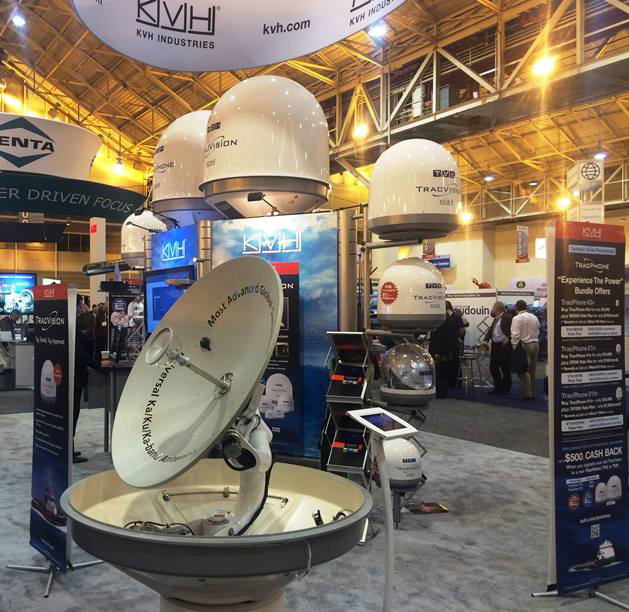Modern satellite communications make it possible for mariners to download in 1 minute a 30-megabyte video file that once would have tied up the line for 15 minutes or more.
KVH Industries shows off its wares at the 2015 International WorkBoat Show. KVH photo.But still there is the complaint: “It’s not fast enough.”
When satcom providers at KVH Industries hear that from a customer, they analyze data usage. It’s not unusual to find fully half a vessel’s data demand is for non-operation use, said Steve Griffin, commercial sales manager for KVH.
In selecting a satellite service, “at the end of the day you’re signing up for a pipe, and how much you can put through that pipe,” Griffin said in a presentation Thursday at Seattle’s Pacific Marine Expo.
Flows through those pipes have grown exponentially. Growth in mobile data is projected to increase by a factor of 13 between 2013 and 2019. In the maritime sector, satellite data transmission has gone from a typical 3 megabytes to 5 megabytes per vessel in 2005 to 25 MB to 30 MB today, Griffin said.
“Capacity does not necessarily equal speed,” Griffin said, because that is essentially determined by bandwidth divided by the number of active devices on board.
It’s likely satcom technology will not keep pace with that demand indefinitely, and vessel operators need to have strategies for managing their maritime connectivity ad onboard networks.
For fishing operators, that means using the technology on the operation side to maximum efficiency in a highly competitive, highly regulated industry, Griffin said. “It’s all about efficiency… because that’s what’s going to make your company profitable,” he said.
Part of that equation is crew who are “digital natives,” able to use the technology, and calling on it for their own needs — family calls, downloads of video and television broadcast programming for down time at sea.
So operators need to identify their must-have data needs and use best management to keep within budget. They can work with service providers to find alternative ways to handle data, like cloud storage on vessels to carry video and prepaid calling for crew members, Griffin suggested.
“Challenge your service provider,” Griffin suggested. Options are expanding with technology; KVH ships a standard 500-GB storage as part of its basic package for new customers. That’s enough to store two full days of television news broadcasts, he said.







